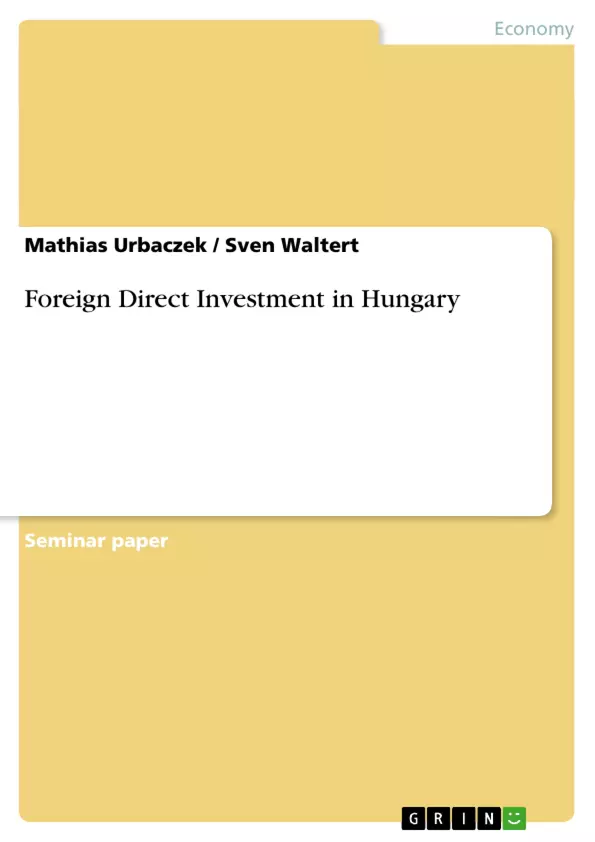Preface
For Hungary and the European Union, the 01. May 2004 is one of the most important dates of the history of Hungary, because they and 9 other countries joined the EU. Finally now the very long time of the separation between Eastern and Western Europe is over. It is now the first time in Europe that all countries of this big continent could life together in peace and can create an economical and political union.
For Hungary it was like for the other new members a very long and hard way to transform the economy to the rules of the market economic system, but they have some advantages because they have started the reform process already before the political change. So as a reason now Hungary has received 31 billion euros as foreign direct investment until 2003. This means they have about 3.100 Euro FDI per inhabitant, only the Czech Republic has received more FDI per inhabitant.
In the assay the authors want to concentrate to the historical background, the business law, the motivation for invest in Hungary and give some data about the FDI in Hungary.
Inhaltsverzeichnis (Table of Contents)
- Preface
- Overview of the Hungarian Economy
- Historical Background of Hungary
- Important business law in Hungary
- Theoretical considerations and evidence form the EU
- Motivation for going international
- Mode of FDI
- Investment in the EU since 1992
- FDI in Hungary
- Reasons for investing in Hungary
- The Repartition of FDI between the different industry's sectors and countries
- Conclusion
Zielsetzung und Themenschwerpunkte (Objectives and Key Themes)
This paper examines the historical background and current state of foreign direct investment (FDI) in Hungary. It aims to provide insights into the economic reforms implemented in Hungary and the factors driving FDI in the country. The authors also aim to present a comprehensive overview of the legal framework and economic environment surrounding FDI in Hungary.
- Historical background of economic reforms in Hungary
- The role of FDI in Hungary's economic development
- Motivation for investing in Hungary
- Structure and distribution of FDI sectors in Hungary
- Hungary's integration into the European Union and its impact on FDI
Zusammenfassung der Kapitel (Chapter Summaries)
- Preface: The preface introduces the significance of Hungary's EU accession in 2004, highlighting the country's journey toward a market-based economy and its subsequent growth in FDI.
- Overview of the Hungarian Economy: This chapter provides a historical context for Hungary's economic reforms, starting with the reform program of Janos Kadar in the 1960s. It outlines Hungary's transformation from a centrally planned economy to a more liberal system, emphasizing the country's membership in international financial institutions and its path toward EU integration.
- Theoretical considerations and evidence form the EU: This chapter explores theoretical frameworks of internationalization and FDI, focusing on the motivations and modes of FDI. It provides an overview of investment trends within the EU since 1992.
- FDI in Hungary: This section delves into the factors that make Hungary an attractive destination for FDI. It explores the reasons behind investments in Hungary, analyzes the distribution of FDI across various industry sectors and countries, and examines the impact of Hungary's geographic location on its role as a transit country.
Schlüsselwörter (Keywords)
The primary keywords and focus topics of this paper include foreign direct investment (FDI), Hungarian economy, economic reforms, EU membership, business law, industry sectors, transit trade, and economic growth.
- Citation du texte
- Mathias Urbaczek (Auteur), Sven Waltert (Auteur), 2005, Foreign Direct Investment in Hungary, Munich, GRIN Verlag, https://www.grin.com/document/42105



